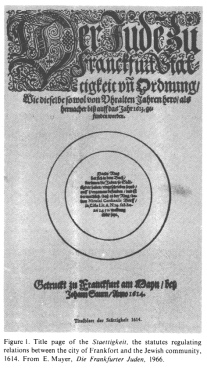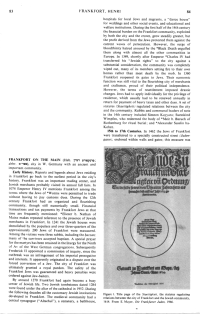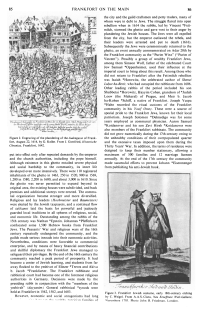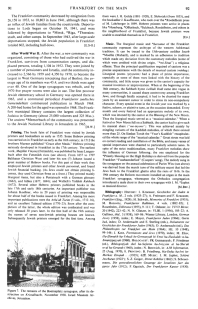<< >>
Encyclopaedia Judaica
Jews in Frankfort on the Main 01: Middle Ages and "Jewish street" ghetto
Trading center Frankfort - riots - royal pardon - Black Death destruction - "Jewish street" ghetto since 1462 - Fettmilch riots of 1614 - readmittance under harsh living conditions since 1616
from: Frankfort on the Main; In: Encyclopaedia Judaica (1971), vol. 7
presented by Michael Palomino (2008)
| Teilen
/ share: |
Facebook |
|
Twitter
|
<FRANKFORT ON THE MAIN, city in W. Germany with an ancient and important community.
Early History.
[Middle Ages: trading center with Jews on fairs - riots and massacre in 1241 - protected Jews and growing Jewish community under royal pardon - institutions]
Reports and legends about Jews residing in Frankfort go back to the earliest period in the city's history. Frankfort was an important trading center, and Jewish merchants probably visited its annual fall fairs. In 1074 Emperor Henry IV mentions Frankfort among the towns where the Jews of *Worms were permitted to trade without having to pay customs dues.
During the 12th century Frankfort had an organized and flourishing community, though still numerically small. Financial transactions and tax payments by Frankfort Jews at that time are frequently mentioned: *Eliezer b. Nathan of Mainz makes repeated reference to the presence of Jewish merchants in Frankfort.
In 1241 the Jewish houses were demolished by the populace and over three-quarters of the approximately 200 Jews of Frankfort were massacred. Among the victims were three rabbis, including the hazzan (ḥazzan) [[cantor]]. many of the survivors accepted baptism.
A special prayer for the martyrs has been retained in the liturgy for the Ninth of Av of the West German congregations. Subsequently Frederick II appointed a commission of inquiry, since the outbreak was an infringement of his imperial prerogative and interests. It apparently originated in a dispute over the forced conversion of a Jew. The city of Frankfort was ultimately granted a royal pardon. The safety of the Frankfort Jews was guaranteed and heavy penalties were ordered against Jew-baiters.
By around 1270 Frankfort had again become a busy center of Jewish life. Two Jewish tombstones dated 1284 were found under the altar of the cathedral in 1952. During the following decades all the customary Jewish institutions developed in Frankfort. The medieval community had a central synagogue ("Altschul") [["Old School"]], a cemetery, a bathhouse, (col. 83)
hospitals for local Jews and migrants, a "dance house" for weddings and other social events, and educational and welfare institutions. During the first half of the 14th century the financial burden on the Frankfort community, exploited by both the city and the crown, grew steadily greater, but the profit derived from the Jews protected them against the current waves of persecution.
[Destruction of the Jewish community during Black Death in 1349 - resettlement since 1360]
However, the surge of bloodthirsty hatred aroused by the *Black Death engulfed them along with almost all the other communities in Europe. In 1349, shortly after Emperor *Charles IV had transferred his *Jewish rights" to the city against a substantial consideration, the community was completely wiped out, many of its members setting fire to their own homes rather than meet death by the mob.
In 1360 Frankfort reopened its gates to Jews. Their economic function was still vital to the flourishing city of merchants and craftsmen, proud of their political independence. However, the terms of resettlement imposed drastic changes. Jews had to apply individually for the privilege of residence, which usually had to be renewed annually in return for payment of heavy taxes and other dues. A set of statutes (Staettigkeit) regulated relations between the city and the community. Rabbis and communal leaders of note in the 14th century included Simeon Kayyara; Suesskind Wimpfen, who redeemed the body of *Meir b. Baruch of Rothenburg for ritual burial; and *Alexander Susslin ha-Kohen.
Encyclopaedia Judaica (1971): Frankfort on the Main, vol. 7, col. 84, title page of the "Staettigkeit", the statutesregulating relations
between the city of Frankfort and the Jewish community, 1614. From E. Mayer: Die Frankfurter Juden, 1966
15th to 17th Centuries.
["Jewish street" ghetto since 1462 - religious life in the ghetto]
In 1462 the Jews of Frankfort were transferred to a specially constructed street (Judengasse) [[Jewish Alley]], enclosed within walls and gates;
[[according to the engraving which speaks of "Judengassen" (Jewish Alleys) this name "Judengasse" standed not only for one single alley but for a hole quarter around the "Judengasse"]];
this measure was (col. 84)
put into effect only after repeated demands by the emperor and the [[criminal]] church authorities, including the pope himself. Although existence in this ghetto entailed severe physical and social hardship to the community, its inner life developed even more intensively. There were 110 registered inhabitants of the ghetto in 1463, 250 in 1520, 900 in 1569, 1,200 in 1580, 2,200 in 1600, and about 3,000 in 1610. Since the ghetto was never permitted to expand beyond its original area, the existing houses were subdivided, and back premises and additional storeys were erected.
The communal organization became stronger and more diversified. Religious and lay leaders (Hochmeister and Baumeister) were elected by the Jewish taxpayers, and a continual flow of takkanot [[major legislative enactment within halakha]] laid the basis for powerful and jealously guarded local traditions in all spheres of religious, social, and economic life. Outstanding among the rabbis of the 15th century was Nathan *Epstein.
[Confiscations - Peasants' War and religious wars - heavy taxes]
Johannes *Pfefferkorn confiscated some 1,500 Hebrew books from Frankfort Jews. The Peasants' War and religious wars [[between Catholic and the new Protestant countries in Europe]] of the 16th century repeatedly endangered the community, and the guilds made serious inroads into their economic activities. Nevertheless, conditions were favourable to commercial enterprise, and by means of heavy financial contributions and skillful diplomacy the Frankfort Jews managed to safeguard their privileges.
By the end of the 16th century the community reached a peak period of prosperity. It had become a center of Jewish learning, and students from far away flocked to the yeshivot [[religious Torah schools]] of Eliezer *Treves and Akiva b. Jacob *Frankfurter. the Frankfort rabbinate and rabbinical court had become one of the foremost religious authorities in Germany. Decisions were made by the presiding rabbi in conjunction with the "members of the yeshivah" (dayyanim) [[judges]]. General rabbinical *synods were held at Frankfort in 1562, 1582, and 1603.
["Christians" in depths with the Jews - Fettmilch riots of 1614 and readmittance of the Jews since 1616 - cultural life - harsh conditions by taxes, by numerical restrictions and marriage restrictions]
However, economic and social antagonisms had long [[...]] the wealthy patrician families of (col. 85)
the city and the guild craftsmen and petty traders, many of whom were in debt to Jews. The struggle flared into open rebellion when in 1614 the rabble, led by Vincent *Fettmilch, stormed the ghetto and gave vent to their anger by plundering the Jewish houses.
Encyclopaedia Judaica (1971): Frankfort on the Main, vol. 7, col. 85, engraving of the plundering of the "Judengasse"
[[quarter]] of Frankfort [[the Fettmilch pogrom]], August 22, 1614, by G. Keller. From J. Gottfried:
Historische Chronica, Frankfort 1642
The Jews were all expelled from the city, but the emperor outlawed the rebels, and their leaders were arrested and put to death (1616). Subsequently the Jews were ceremoniously returned to the ghetto, an event annually commemorated on Adar 20th by the Frankfort community as the "Purim Winz" ("Purim of Vincent"). Possibly a group of wealthy Frankfort Jews, among them Simeon Wolf, father of the celebrated Court Jew Samuel *Oppenheimer, used their influence at the imperial court to bring about this result. Among those who did not return to Frankfort after the Fettmilch rebellion was Isaiah *Horowitz, the celebrated author of Shenei Luhot [[Luḥot]] Ha-Berit, who had occupied the rabbinate from 1606. Other leading rabbis of the period included his son Shabbetai *Horowitz, Hayyim [[Ḥayyim]] Cohen, grandson of *Judah Loew (the Maharal) of Prague, and Meir b. Jacob ha-Kohen *Schiff, a native of Frankfort.
Joseph Yuspa *Hahn recorded the ritual customs of the Frankfort community in his Yosif Omez (Omeẓ). These were a source of special pride to the Frankfort Jews, known for their local patriotism, Joseph Solomon *Delmedigo was for some years employed as communal physician. Aaron Samuel *Koidanover and his son Zevi (Ẓevi) Hirsh *Koidanover were also members of the Frankfort rabbinate.
The community did not grow numerically during the 17th century owing to the unhealthy conditions of their overpopulated quarter and the excessive taxes imposed upon them during the Thirty Years' War. In addition, the terms of residence were designed to keep their number stationary, allowing a maximum of 500 families and 12 marriage licenses annually.
At the end of the 17th century the community made successful efforts to prevent Johann *Eisenmenger from publishing his anti-Jewish book.> (col. 86)
<Printing.
The book fairs of Frankfort were visited by Jewish printers and booksellers as early as 1535. Some Hebrew printing was carried on in Frankfort as early as the 16th century; in 1512 the brothers Murner published "Grace after Meals". Hebrew printing seriously developed in Frankfort in the 17th century. The earliest work, Megillat Vinzenz [[Megillat Vinẓenẓ]] (Fettmilch), was published by Isaac Langenbuch after the Fettmilch riots (see above). From 1657 to 1707 Balthasar Christian Wust and later his son (?) Johann issued a great number of Hebrew books. For this part of their work they employed Jewish printers and other Jewish personnel, and found Jewish financial backing. (As Jews could not obtain printing licenses, they used Christian firms as a front). They printed mainly liturgical items, but also a Pentateuch with a German glossary (1662), and bibles (1677, 1694); and Wallich's Yiddish Kuhbuch (1672).
Several other Hebrew printers published books in the late 17th and early 18th centuries. An important publisher was Johann Koellner, who in 20 years of printing was responsible for about half of the books issued in Frankfort. Among his more important publications were the Arba'ah Turim (5 vols., 1712-16), and an excellent Talmud edition (1770-23). Soon after the completion of the latter, the whole edition was confiscated and was only released 30 years later.> (col. 91)
<Music.
The liturgical music and *hazzanut (ḥazzanut) [[cantorial performance]] of the Frankfort community represent the archetype of the western Ashkenazi tradition. It can be traced to the 15th-century codifier Jacob *Moellin (Maharil), and is marked by an adherence to tradition which made any deviation from the customary melodies (some of which were credited with divine origin, "*mi-Sinai") a religious offense. Thus the principal qualification required of cantors was a precise acquaintance with the details of musical custom (minhag).
Liturgical poems (piyyutim) had a place of prime importance, especially as some of them were linked with the history of the community, and little scope was given to the cantor's capacity for musical invention or improvisation. When at the beginning of the 16th century, the Sabbath hymn Lekhah Dodi came into vogue in many communities, it caused sharp controversy among Frankfort Jews, and though finally accepted, it had to be chanted for many years by an assistant cantor in order to stress its non-compulsory character.
Every special event in the Jewish year was marked by a festive, solemn, or plaintive tune, as the occasion demanded. Every month and every festival had an appropriate melody of its own, which was intoned by the cantor at the Blessing of the New Moon. Thus the liturgical music served as a "musical calendar".
When a festival or New Moon fell on a Sabbath, the cantor had to give each its musical share ("me-inyono"). This was achieved mainly by mingling variants of the Kaddish melodies, of which there existed more than 25.
On Simhat Torah [[Simḥat Torah]] the "Year's Kaddish" recapitulated the whole range of the "musical calendar". Great stress was laid on correct reading and cantillation of the Bible, and many verses of special importance were chanted to particularly solemn tunes.
In spite of the strict traditionalism, many Frankfort melodies show the influence of German folksong; the one employed for the *Priestly blessing on the High Holidays is derived from the popular Frankfort "Fassbaenderlied" (Coopers' song). The melody sung in the synagogue on the annual celebration of Purim Winz (see above) was derived from the march tune of the military escort that led the Jews back to the Frankfort ghetto after the riots of 1616.> (col. 92)
| Teilen
/ share: |
Facebook |
|
Twitter |
Č Ḥ ¦
Ṭ Ẓ
ā ć č ḥ ī ¨ ū ¸ ẓ
ā ć č ḥ ī ¨ ū ¸ ẓ
^

![Encyclopaedia
Judaica (1971): Frankfort on the Main, vol. 7, col.
85, engraving of the plundering of the
"Judengasse" [[quarter]] of Frankfort
[[the Fettmilch pogrom]], August 22, 1614, by G.
Keller. From J. Gottfried: Historische Chronica,
Frankfort 1642 Encyclopaedia Judaica (1971): Frankfort on the
Main, vol. 7, col. 85, engraving of the plundering
of the "Judengasse" [[quarter]] of
Frankfort [[the Fettmilch pogrom]], August 22, 1614,
by G. Keller. From J. Gottfried: Historische
Chronica, Frankfort 1642](EncJud_juden-in-Frkft-Main-d/EncJud_Frankfurt-am-Main-band7-kolonne85-Fettmilch-pogrom-15pr.jpg)



 index
index